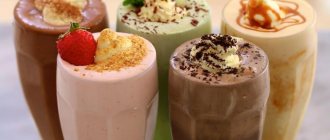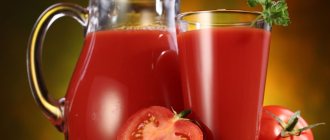Useful tips
Coffee is undoubtedly one of the most popular soft drinks
on our planet, the addiction to which begins for many at a fairly young age.
Involuntarily, a completely logical question arises - how does consuming large amounts of coffee and its various variations affect how much a person weighs?
? How many calories are in a regular cup of ground coffee? What about instant?
Finally, how do various additives, such as milk or sugar,
? Now you will find out the answers to all these questions.
How many calories are in a spoon of coffee?
Calorie content of ground coffee
Coffee contains an extremely small amount of calories, so this drink in its pure form is not one of those that will add extra pounds. This can be proven using banal mathematics. And we'll start with ground coffee. But first we need the following information: one teaspoon
ground coffee holds approximately 4 grams (if you scoop up coffee without a slide) or 5-6 grams of product (if you scoop up a spoon of coffee with a slide).
Next, in order not to be unfounded, we recommend picking up a package of natural ground coffee. Read the nutritional
, which is usually present on the packaging or on an additional sticker placed on a pack of coffee.
Calorie content of one spoon of ground coffee
From this information it is clear that the calorie content of ground coffee is 202 kilocalories per 100 grams of product. Thus, one level spoon of ground coffee contains about 8 kilocalories, and one heaped spoon of ground coffee contains approximately 12 kilocalories.
Is it possible to have coffee with high blood pressure?
There is always a lot of controversy surrounding coffee. One of the most common is related to whether drinking coffee affects blood pressure, and if it does, how exactly? In fact, hundreds of studies have been conducted to identify the relationship between blood pressure and coffee consumption.
But none of the studies have found a direct link between coffee consumption and an increased risk of a significant increase in blood pressure. In this case, we were talking about an amount not exceeding 400 milligrams of caffeine per day. Moreover, no relationship was found with an increase in cardiovascular diseases.
How many calories are in coffee without sugar?
How many calories are in a cup of coffee
So now we know that a teaspoon of pure ground coffee contains approximately 8-12 kilocalories, while a teaspoon
instant coffee contains about 2.5-3.5 kilocalories of product. Does the number of calories change during the final preparation of the product, that is, when preparing a coffee drink?
The answer is clear - if it changes, then only to a lesser extent. And these changes are extremely minor.
How many calories are in one cup of ground coffee?
It's very simple - the answer depends on the type of coffee drink. Take, for example, espresso, which is usually brewed from freshly ground coffee.
. Classic espresso is 7-10 grams of product per approximately 30 grams of water. Thus, a cup of espresso without milk and sugar will add 14 to 20 kilocalories to your body.
Fans of double espresso (doppio), which is essentially the same espresso, only with double the amount
water and coffee (that is, approximately 60 grams of water for 14-20 grams of coffee), consumed with one serving of the drink without additives from 28 to 40 kilocalories.
Americano is a coffee drink for those who do not like a very concentrated coffee taste. Essentially, an Americano is a highly diluted espresso or double espresso. Moreover, according to the classic cooking
, it can be diluted in almost half a liter of water. Thus, the calorie content of one cup of classic Americano made from ground coffee is the same 14-20 kilocalories.
How many calories are in one cup of instant coffee drink?
The nutritional energy value of one cup of coffee drink made from instant coffee is extremely scanty
, although it also directly depends on its strength. Usually coffee is diluted in one hundred grams of water. Added one spoon of coffee - consumed about two kilocalories; two spoons – 4 kilocalories.
It is well known that the recommended calorie intake per day for women is 2000 kilocalories, and for men – 2500 kilocalories. Of course, these are average data
, since this norm depends on age, body weight, type of activity, health status, climate and many, many other factors.
Conclusion: then a couple of cups of coffee without additives
per day do not pose any danger in terms of the risk of gaining excess weight.
Calorie content of tea with honey
Honey is not only a beloved sweet by many, but also a healthy product that many people use to replace sugar. Even though the calorie content of honey is not much lower than that of sugar, you will get more benefits from a spoon of honey. The carbohydrates it contains are more easily absorbed by the body and are not stored as fat reserves, and the amount of essential elements in it is simply off the charts! These are B vitamins, vitamin C, enzymes, amino acids, iodine, potassium, iron and other essential microelements.
The calorie content of honey depends on its variety: the most “dietary” is buckwheat honey - 100 g of the product contains 300 kcal. Dark varieties of honey can reach a calorie content of 400 kcal per 100 g. On average, a teaspoon of honey contains about 26 calories. By adding a couple of spoons to tea, you will get about 60 kcal per serving.
Tea with honey is an excellent remedy for treating cold symptoms. The main thing is not to add honey to boiling water - this can “kill” the beneficial substances and the drink will lose its healing properties. The temperature of the drink should not be higher than 40 degrees. Honey contains antioxidants, as well as immune-stimulating and antimicrobial substances. When combined with black or green tea, you get a real medicine for all diseases. However, if you are watching your caloric intake and are concerned about extra pounds, your consumption of this drink should be limited to one cup per day.
ul
Calorie content of coffee with sugar
How many calories are in coffee with sugar?
Not everyone likes the bitter taste of pure ground or instant coffee, so they drink it with additives. The most popular additive is, without a doubt, granulated sugar.
Before you estimate how many kilocalories one teaspoon of sugar adds to a coffee drink, you should remember how many grams of granulated sugar
fits in this spoon. And the data is as follows: a level teaspoon of sugar is about 5 grams, and a heaped teaspoon is 7 grams.
How many calories are in a spoonful of sugar?
The calorie content of granulated sugar is 387 kilocalories per 100 grams of product; means 1 level teaspoon of sugar
contains approximately 19 kilocalories; the number of kilocalories in a heaped teaspoon of granulated sugar is approximately 27 kilocalories.
For clarity: one cup of espresso contains an average of 63 kilocalories - for one cup, this is not so much. But if you consume two or even three servings a day
, then you will gain 189 kilocalories. And if you add milk or cream, then even more. How much more?
Calorie table for the most popular coffee drinks
To make it more convenient to immediately find the calorie content of the drink you are interested in, you need to use the table:
| Drink name | Number of kcal in one serving |
| Natural coffe | 1-2 |
| Americano | 15 |
| Latte | 250 |
| Cappuccino | 150 |
| Mochaccino | 290 |
| Frappuccino | 400 |
| Glasse | 125 |
| Latte Macchiato | 60 |
| Instant coffee | 14 |
So, coffee is a delicious drink that itself contains very few calories, which is why it is allowed on almost all diets. The calorie content of coffee increases rapidly if you add milk, cream, sugar, condensed milk or chocolate syrup to it. To make it easier to monitor the amount of calories in your diet received along with coffee, it is convenient to use the table and the calorie values of coffee additives.
How many calories are in 1 cup of coffee:
♦ Category: Healthy products.
Read for Health one hundred percent:
- How many calories are in tomato juice from different manufacturers?
- The benefits and harms of white chocolate: history, composition and calorie content
- It’s interesting to understand the benefits of chicory
- Dietary educational program: how many calories are in fish
- Tea with lemon balm - enjoying life and health benefits
- No need for migraine pills?
- Products containing proteins, fats, carbohydrates: tables, descriptions, features
- How to eat healthy and healthy with chronic pancreatitis
How many calories are in a latte?
How many calories are in coffee with milk?
An additive in the form of milk or cream only gives the coffee drink its characteristic softness of taste. However, milk in coffee usually means extra calories. Exactly how much depends on the fat content of the milk
. So, for example, 100 grams of milk with a fat content of 1 percent contains 42 kilocalories; a product with a fat content of 2.5 percent already contains 54 kilocalories.
How many calories are in one serving of milk added to coffee?
The answer to this question directly depends on how much milk you add to your coffee. If it's a couple of teaspoons
(one such spoon is 5 grams of milk), then you add literally 5 kilocalories of nutritional value to the finished drink.
In other words, a cup of drink (for example, espresso) with two teaspoons of milk contains approximately 22 kilocalories. Add two tablespoons of sugar there - you get a total of about 68 kilocalories
. A cup of instant coffee without sugar and with milk in approximately the same proportion - about 10 kilocalories; with sugar – 56 kilocalories.
By the way, why exactly two spoons? We took the standard packaging of portioned coffee cream as a basis - it is usually packaged in 10 gram quantities
. The calorie content of such cream is much higher - 10 percent cream contains 118 kilocalories per 100 grams of product.
Calorie content of gourmet drinks
https://youtube.com/watch?v=wdtobFE0-L8
If everything is more or less clear with black coffee, then its various types with tempting names, which are often replete with the menu of any cafe and restaurant, can be fraught with a lot of pitfalls in the form of extra calories. The most harmless in this sense is classic espresso - fairly strong coffee to which nothing is added. A small invigorating cup will add only 2-3 kcal. It's more difficult with varieties of espresso. For example, a serving of espresso macchiato, which is usually 250 milliliters in volume, contains 55 kcal. Calorie content is increased by adding milk foam. But espresso con panna will have twice the calorie content due to the white foam with the addition of ground cinnamon.
A serving of Americano will not harm those losing weight. A large cup with a volume of 400-450 milliliters contains only about 15 kcal. The same, unfortunately, cannot be said about the very tasty mocaccino, brewed on the basis of espresso with the addition of chocolate and milk, which will add up to 290 kcal. And this is only for 100 milliliters! A beautiful latte is traditionally served in special oblong glass cups so that the layers of coffee, milk and thick foam are clearly visible. A serving of this drink, which is usually 300–350 milliliters, contains 230–250 kcal. And this is without adding sugar to it. Spicy Irish coffee, which contains espresso, cream, whiskey and sugar in varying proportions, has a slightly lower energy value. There are 170 calories per 150 milliliters.
A standard 150-milliliter serving of cappuccino contains at least 200 kcal. The fact is that it is prepared in such a way that sugar is added to the initially harmless espresso in terms of calorie content, as well as thick milk foam, whipped from high-fat milk and cream. You don’t have to add sugar, but this won’t help the situation much, reducing calorie content by 24–48 kcal.
Coffee calories
Calories in coffee with cinnamon
Cinnamon, which is usually added to the drink in the amount of half a teaspoon (about 3 grams), gives coffee a special piquancy. Considering the nutritional value of cinnamon
(247 kilocalories per 100 grams of product), you can estimate that a serving of cinnamon increases the calorie content of one cup of coffee by about 7.5 kilocalories.
The coffee drink latte, which is essentially espresso coffee with milk,
. Most often, lattes are prepared in such a way that there is twice as much milk in the finished drink as coffee.
When and who can drink coffee?
You love coffee and cannot imagine a single morning without this invigorating drink. At the same time, you drink several cups a day, not paying attention to your well-being and the time of day.
Is it worth giving up this habit, for example, during pregnancy?
Pregnancy is a period when a woman is forced to limit herself in many ways so as not to harm the health of the unborn child. But should coffee be included in the list of restrictions?
There are different opinions on this matter, but it makes sense to turn to authoritative sources. One of them is the World Health Organization (WHO).
WHO recommendation
If your pregnancy is progressing normally, there is no need to stop drinking coffee during pregnancy. However, it makes sense to limit its amount - no more than 300 milligrams of caffeine per day.
As you know, one hundred grams of coffee contains 40 milligrams of caffeine. It turns out that 300 milligrams of caffeine is 750 grams of coffee drink. This is approximately the amount of caffeine found in large coffee from the American coffee chain Starbucks.
According to research, 300 milligrams of caffeine per day is exactly the minimum dose after which caffeine addiction can begin to form. Experts from the Russian Federal Research Center (FRC) of Nutrition, Biotechnology and Food Safety do not agree with WHO recommendations.
The benefits of coffee and coffee with milk
Coffee is a healthy drink that contains caffeine. Caffeine stimulates all processes in the body, speeds up metabolism and has a beneficial effect on the cardiovascular system. Unfortunately, frequent consumption of coffee can lead to a decrease in calcium levels in the body, so it is recommended to add milk to coffee drinks.
As a rule, people drink pure espresso to invigorate and gain strength. Gourmets and coffee lovers often prefer drinks with various additives. The most common additive for coffee is milk. With it, the drink loses its bitterness, but retains its unique coffee taste, which is additionally mixed with delicate creamy notes.
Coffee has long been transformed from a simple drink into an exquisite dessert. On every street corner there are coffee shops offering the buyer a variety of types of drinks: espresso, cappuccino, mochaccino, glasse, flat white, corretto, macchiato... Of course, the calorie content of all coffee drinks varies greatly. The number of calories in one serving of coffee depends on the type of coffee, serving size and the presence of various additives.
You can often meet groups of girls in cafes who always order a cup of coffee with their diet salad. It has been noticed that it is much easier for people losing weight to give up sugar than to stop drinking coffee. Not everyone knows how positively or negatively this drink affects excess weight, which means this issue needs to be sorted out.
Conclusions:
- Dairy products contain 1.5-3.5% fat - 10-12 kcal per tablespoon. A natural drink has about 4 kcal per 200 ml, and instant coffee has about 10. It’s easy to calculate the average calorie content.
- In coffee shops, a latte has more calories than a cappuccino, because milk with at least 3% fat content is used, and a latte has more of it.
- The more dairy product (milk, foam) in a cup, the more calories you will get.
- If you prefer natural coffee, you don’t have to count calories per cup - there are no more than 4-6, which is almost insignificant for the overall diet.
What you need to know about instant coffee
The main ingredient of the invigorating drink is roasted coffee beans. Based on scientific materials, the soluble variety was created in 1899 by the talented Swiss chemist Max Morgenthaler. From that moment on, this type of drink gained great popularity. This popularity is explained by its simple recipe. The drink retains its aroma, taste and invigorating properties. The calorie content of instant coffee is less than that of grain coffee. It is worth noting that caffeine is also found in tea leaves.
There are 3 types of instant drink:
- Sublimated. The grains are ground, boiled with water, and then dried by freezing. This is one of the most difficult processes for creating an instant drink, however, thanks to it the drink retains its quality taste and aroma.
- Powder. This is the very first version of an instant drink. The grains are ground to a powder, then water is passed through them under vacuum and dried.
- Granulated. This is a new type of drink. The grains are turned into powder, after which they are moistened and rolled into granules. This method of creating coffee allows it to dissolve faster in hot water.
Which one to choose is up to you to decide. The calorie content of instant coffee per 100 grams in each of them is approximately the same.
Positive and negative properties
Important! It is always worth remembering that such a wonderful drink has its positive and negative qualities.
One of its positive properties is the fact that it contains over 1200 various chemical elements, including vitamins PP, B1 and B2, macro- and microelements, potassium, calcium, sodium, iron, magnesium. Most of them are involved in the basic processes that ensure the normal functioning of the human body, so maintaining their quantity in it is extremely important.
Coffee contains vitamins PP, B1 and B2, macro- and microelements, potassium, calcium, sodium, iron, magnesium
The described drink also has a diuretic effect, as well as a slight laxative effect. In addition, thanks to the oils it contains, it is quite high in calories, so if you are on a diet and want to lose weight, before drinking a cup of this drink, you need to find out how many calories are in coffee with sugar.
Important! Since coffee is a tonic drink, it can invigorate a person for a short period of time, as well as increase his attention and concentration.
For the same reasons, it is used for low blood pressure or migraine headaches. Drinks based on it are also indicated for patients with diabetes; in addition, they should be consumed if you have liver disease.
There is also a cosmetological use of this plant, for example, in the form of facial masks that rejuvenate the skin. In addition to the positive qualities of use, there are also negative aspects of this process. For example, coffee brewed with boiling water or espresso can significantly increase cholesterol levels in the blood. This, in turn, can lead to a risk of cardiovascular disease.
Coffee will help with low blood pressure or headaches
In addition, under the influence of this drink, calcium can be intensively removed from the body, which causes increased bone fragility. For this reason, this drink is strictly contraindicated for children under 2 years of age, while older children can be given it 4 times more diluted than adults. This also applies to pregnant women.
In any case, if you have been diagnosed with chronic diseases of the nervous system or gastrointestinal tract, and in connection with this a special diet has been established, you should consult with your doctor about the possibility of consuming this drink in the future. Also, if you are advised to lose weight, find out in advance how many calories are in a mug of coffee with sugar, and add them to the others you get at lunch.
Coffee is included in masks that rejuvenate facial skin
What are the benefits of coffee?
There is an opinion that coffee and the caffeine it contains can cause health problems, especially if consumed frequently. It is important to understand that excessive consumption of any product can negatively affect the functioning of some organs, so you need to know in moderation in everything. But consuming your favorite drink within reasonable limits can, in addition to gastronomic pleasure, also have a beneficial effect on the body. Here are a few facts to support this:
- This is an excellent antidepressant of natural origin. Coffee activates brain processes, improves performance, and also helps cope with stress.
- Able to improve mood due to the production of the happiness hormone - serotonin.
- Memory improves.
- It has a beneficial effect on blood circulation, including the brain, strengthens the walls of blood vessels, reduces the level of cholesterol in the blood, the excess of which contributes to the occurrence of atherosclerosis.
- Antioxidants in the drink charge you with vigor and energy, prevent premature aging, reduce the risk of developing many chronic diseases such as Parkinson's disease, type 2 diabetes and even some types of cancer.
- Promotes weight loss, since regular consumption accelerates metabolism in the body.
- Useful for people suffering from low blood pressure (hypotension).
- Reduces the likelihood of stroke, Alzheimer's disease, atherosclerosis, diabetes.
What kind of coffee can you drink on a diet?
Despite the fact that many nutritionists advise completely excluding coffee from your diet during the period of weight loss, you can still drink it at this time, since it itself contains very few calories. In this case, it will be necessary to exclude various additives. It is worth abandoning those types of drinks that necessarily require the inclusion of the same cream in their composition. These include, for example, Glace, Frapuccino, Mocha and Latte.
Iced coffee is a high-calorie type
Due to their ingredients, the listed drinks become high-calorie, which, naturally, does not contribute to weight loss. If you name low-calorie varieties that are not capable of ruining your figure, then these are Ristretto, Americano and Espresso. In terms of their energy indicators, they are very close to natural black.
In addition, it is also worth noting the fact that coffee drinkers sometimes notice a weight loss effect, which is why it is believed that coffee can “burn” fat. This is due to the fact that it has some diuretic effect. It is by removing excess fluid from the body that the extra pounds are lost. However, you should not abuse this drink, as it can harm the human nervous system in case of overdose. The standard norm is 3 small cups per day.
We should also talk about the so-called green coffee, which has recently been advertised as a great way to lose weight. In principle, this is the same coffee of standard classic varieties, but unripe. Unlike the usual one, it has pale olive-colored grains.
The medicinal properties, as well as the ability to “burn” fat with this drink have not been proven, but green coffee contains fewer calories in its beans than regular coffee, which is why it can be used as food while losing weight. In addition, it has a pronounced diuretic effect, which is also a plus for a person losing weight.
Green coffee contains fewer calories in its beans than regular coffee.
The main thing is not to consume those types of it that involve the use of fatty products: cream, chocolate, condensed milk.
Note! To summarize, we can say that coffee itself cannot significantly affect your energy balance, since it contains very few calories.
If you adhere to this rule, then you can drink coffee within reasonable limits even when you are on the most difficult diet. In this case, this drink can cheer you up and prevent depression, which can be accompanied by a sudden loss of excess weight. Drink natural black coffee without sugar and forget about excess weight!








